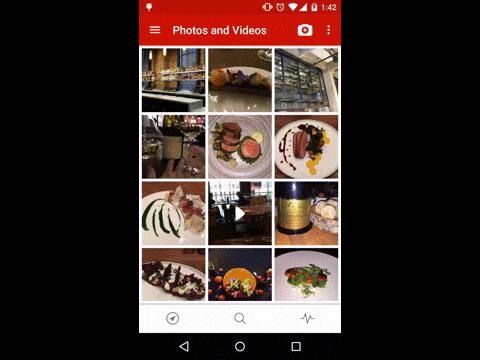
- Android App中读取XML与JSON格式数据的基本方法示例
- Android使用SQLite数据库的简单实例
- Android GridView仿微信朋友圈显示图片
- android异步请求服务器数据示例
- Android 圆角 ImageView类可设置弧度(代码简单)
- Android应用中加入微信分享简单方法
- [Java4Android]15_面向对象基础(四)
- Android中使用Vectors(2)绘制优美的路径动画
- android 默认时间格式修改方法
- 分析Android App中内置换肤功能的实现方式
- Java4Android开发教程(四)java的变量
- Android ViewPager实现无限循环效果
- Android实现GridView中ImageView动态变换的方法
- android 自定义TabActivity的实例方法
- Android触屏测试实例代码
- Android短信操作常见协议和常用代码
- Android仿微信二维码和条形码
- 解析android 流量监测的实现原理
- android 解析json数据格式的方法
- Android异步回调中的UI同步性问题分析
- Android中使用tcpdump、wireshark进行抓包并分析技术介绍
- Android使用OKHttp包处理HTTP相关操作的基本用法讲解
- Android项目实战之仿网易顶部导航栏效果
- Android 中使用 AsyncTask 异步读取网络图片
- Android 实现不依赖焦点和选中的TextView跑马灯
- Android Mms之:深入MMS支持
- Android观察者模式实例分析
- ListView的View回收引起的checkbox状态改变监听等问题解决方案
- Android开发中的9个常见错误和解决方法
- Android计时器chronometer使用实例讲解
Android的多媒体管理库Glide的基本使用示例
Glide 是一个android平台上的快速和高效的开源的多媒体资源管理库, 提供 多媒体文件的压缩,内存和磁盘缓存, 资源池的接口。
Glide 支持获取,解压展示视频, 图像和GIFs, Glide有一个可弹性的api可以让开发者自定义网络栈技术, 默认使用HttpUrlConnection , 你可以替换为 Google's Volley或者 OkHttp
Glide 开始的目的是提供一个快速和平滑展示图片列表, 但是Glide对你需要拉取, resize 和展示远程的图片这些场景都是很管用的.
Glide最简单的使用案例就是从远程服务器或者本地文件系统加载图片,把它们放在磁盘与内存缓存中,然后加载到view上。它可以用在全市图片的app中,Glide为包含图片的滚动列表做了尽可能流畅的优化。
对象池
Glide原理的核心是为bitmap维护一个对象池。对象池的主要目的是通过减少大对象的分配以重用来提高性能。
Dalvik和ART虚拟机都没有使用compacting garbage collector,compacting garbage collector是一种模式,这种模式中GC会遍历堆,同时把活跃对象移到相邻内存区域,让更大的内存块可以用在后续的分配中。因为安卓没有这种模式,就可能会出现被分配的对象分散在各处,对象之间只有很小的内存可用。如果应用试图分配一个大于邻近的闲置内存块空间的对象,就会导致OutOfMemoryError,然后崩溃,即使总的空余内存空间大于对象的大小。
使用对象池还可以帮助提高滚动的性能,因为重用bitmap意味着更少的对象被创建与回收。垃圾回收会导致“停止一切(Stop The World)”事件,这个事件指的是回收器执行期间,所有线程(包括UI线程)都会暂停。这个时候,图像帧无法被渲染同时UI可能会停滞,这在滚动期间尤其明显。

下载
Glide的GitHub项目地址 https://github.com/bumptech/glide
可以在github上下载 release page.
或者使用Gradle:
repositories {
mavenCentral()
}
dependencies {
compile 'com.github.bumptech.glide:glide:3.3.+'
compile 'com.android.support:support-v4:19.1.0'
}
repositories {
mavenCentral()
}
dependencies {
compile 'com.github.bumptech.glide:glide:3.3.+'
compile 'com.android.support:support-v4:19.1.0'
}
Maven
<dependency> <groupId>com.github.bumptech.glide</groupId> <artifactId>glide</artifactId> <version>3.3.1</version> <type>aar</type> </dependency> <dependency> <groupId>com.google.android</groupId> <artifactId>support-v4</artifactId> <version>r7</version> </dependency> <dependency> <groupId>com.github.bumptech.glide</groupId> <artifactId>glide</artifactId> <version>3.3.1</version> <type>aar</type> </dependency> <dependency> <groupId>com.google.android</groupId> <artifactId>support-v4</artifactId> <version>r7</version> </dependency>
使用
Glide使用起来很简单,而且不需要任何特别的配置就自动包含了bitmap pooling 。
DrawableRequestBuilder requestBuilder = Glide.with(context).load(imageUrl); requestBuilder.into(imageView);
这就是加载一张图片的全部要求。就像安卓中的很多地方一样,with() 方法中的context到底是哪种类型是不清楚的。有一点很重要需要记住,就是传入的context类型影响到Glide加载图片的优化程度,Glide可以监视activity的生命周期,在activity销毁的时候自动取消等待中的请求。但是如果你使用Application context,你就失去了这种优化效果。
注:其实以上的代码是一种比较规范的写法,我们更熟悉的写法是:
Glide.with(context)
.load("http://inthecheesefactory.com/uploads/source/glidepicasso/cover.jpg")
.into(ivImg);
简单的例子
// For a simple view:
@Override
public void onCreate(Bundle savedInstanceState) {
...
ImageView imageView = (ImageView) findViewById(R.id.my_image_view);
Glide.with(this).load("http://goo.gl/h8qOq7").into(imageView);
}
// For a list:
@Override
public View getView(int position, View recycled, ViewGroup container) {
final ImageView myImageView;
if (recycled == null) {
myImageView = (ImageView) inflater.inflate(R.layout.my_image_view,
container, false);
} else {
myImageView = (ImageView) recycled;
}
String url = myUrls.get(position);
Glide.with(myFragment)
.load(url)
.centerCrop()
.placeholder(R.drawable.loading_spinner)
.crossFade()
.into(myImageView);
return myImageView;
}
// For a simple view:
@Override
public void onCreate(Bundle savedInstanceState) {
...
ImageView imageView = (ImageView) findViewById(R.id.my_image_view);
Glide.with(this).load("http://goo.gl/h8qOq7").into(imageView);
}
// For a list:
@Override
public View getView(int position, View recycled, ViewGroup container) {
final ImageView myImageView;
if (recycled == null) {
myImageView = (ImageView) inflater.inflate(R.layout.my_image_view,
container, false);
} else {
myImageView = (ImageView) recycled;
}
String url = myUrls.get(position);
Glide.with(myFragment)
.load(url)
.centerCrop()
.placeholder(R.drawable.loading_spinner)
.crossFade()
.into(myImageView);
return myImageView;
}
Volley
如果你想使用Volley:
Gradle
dependencies {
compile 'com.github.bumptech.glide:volley-integration:1.0.+'
compile 'com.mcxiaoke.volley:library:1.0.+'
}
dependencies {
compile 'com.github.bumptech.glide:volley-integration:1.0.+'
compile 'com.mcxiaoke.volley:library:1.0.+'
}
Maven:
<dependency> <groupId>com.github.bumptech.glide</groupId> <artifactId>volley-integration</artifactId> <version>1.0.1</version> <type>jar</type> </dependency> <dependency> <groupId>com.mcxiaoke.volley</groupId> <artifactId>library</artifactId> <version>1.0.5</version> <type>aar</type> </dependency> <dependency> <groupId>com.github.bumptech.glide</groupId> <artifactId>volley-integration</artifactId> <version>1.0.1</version> <type>jar</type> </dependency> <dependency> <groupId>com.mcxiaoke.volley</groupId> <artifactId>library</artifactId> <version>1.0.5</version> <type>aar</type> </dependency>
然后在你的Activity或者程序中,注册Volley为基本模块
public void onCreate() {
Glide.get(this).register(GlideUrl.class, InputStream.class,
new VolleyUrlLoader.Factory(yourRequestQueue));
...
}
public void onCreate() {
Glide.get(this).register(GlideUrl.class, InputStream.class,
new VolleyUrlLoader.Factory(yourRequestQueue));
...
}
OkHttp
Gradle:
dependencies {
compile 'com.github.bumptech.glide:okhttp-integration:1.0.+'
compile 'com.squareup.okhttp:okhttp:2.0.+'
}
dependencies {
compile 'com.github.bumptech.glide:okhttp-integration:1.0.+'
compile 'com.squareup.okhttp:okhttp:2.0.+'
}
Maven:
<dependency> <groupId>com.github.bumptech.glide</groupId> <artifactId>okhttp-integration</artifactId> <version>1.0.1</version> <type>jar</type> </dependency> <dependency> <groupId>com.squareup.okhttp</groupId> <artifactId>okhttp</artifactId> <version>2.0.0</version> <type>jar</type> </dependency> <dependency> <groupId>com.github.bumptech.glide</groupId> <artifactId>okhttp-integration</artifactId> <version>1.0.1</version> <type>jar</type> </dependency> <dependency> <groupId>com.squareup.okhttp</groupId> <artifactId>okhttp</artifactId> <version>2.0.0</version> <type>jar</type> </dependency>
然后在你的Activity或者程序中,注册Volley为基本模块
public void onCreate() {
Glide.get(this).register(GlideUrl.class, InputStream.class,
new OkHttpUrlLoader.Factory(yourOkHttpClient));
...
}
public void onCreate() {
Glide.get(this).register(GlideUrl.class, InputStream.class,
new OkHttpUrlLoader.Factory(yourOkHttpClient));
...
}
- Android开发之WebView输入框提示解决办法
- 基于AnDroid FrameLayout的使用详解
- Android 获取屏幕高度,标题高度,状态栏高度
- 解析如何在android中增加gsensor驱动(MMA7
- Android键盘显示与隐藏代码
- android开发教程之系统资源的使用方法 andr
- Android 自定义View步骤